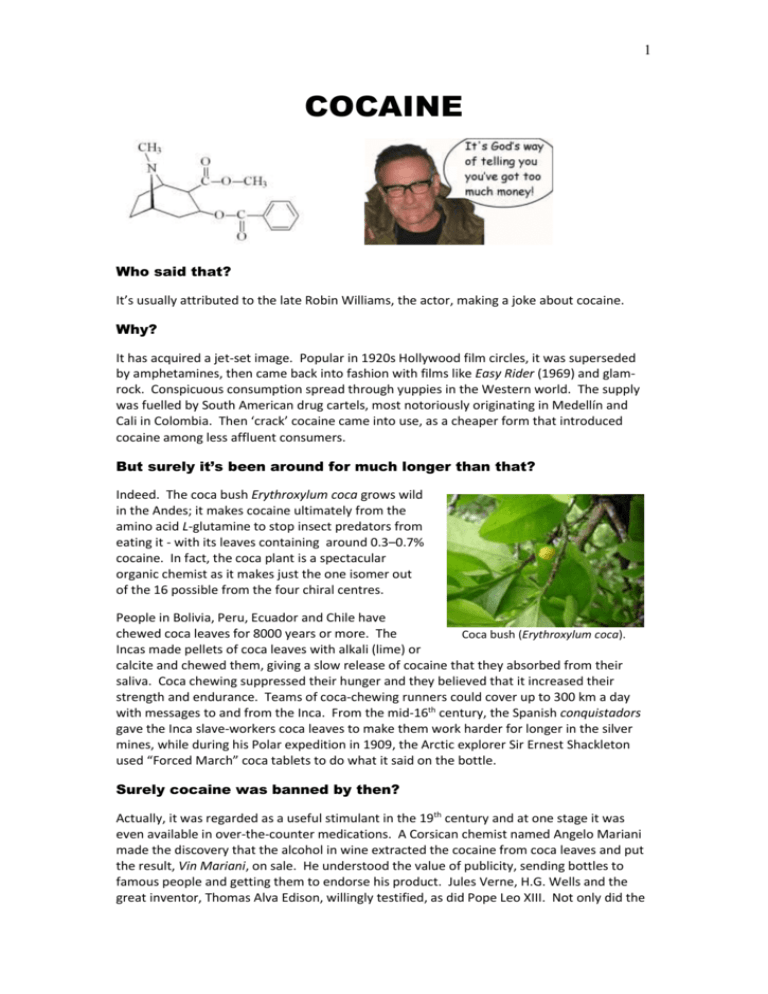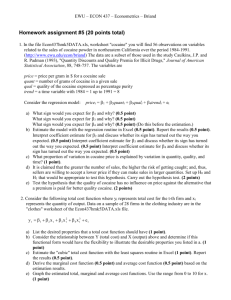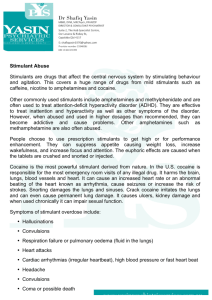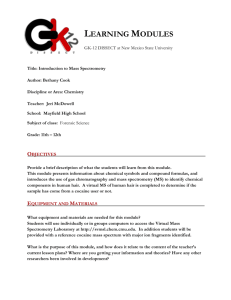COCAINE MOTM
advertisement

1 COCAINE Who said that? It’s usually attributed to the late Robin Williams, the actor, making a joke about cocaine. Why? It has acquired a jet-set image. Popular in 1920s Hollywood film circles, it was superseded by amphetamines, then came back into fashion with films like Easy Rider (1969) and glamrock. Conspicuous consumption spread through yuppies in the Western world. The supply was fuelled by South American drug cartels, most notoriously originating in Medellín and Cali in Colombia. Then ‘crack’ cocaine came into use, as a cheaper form that introduced cocaine among less affluent consumers. But surely it’s been around for much longer than that? Indeed. The coca bush Erythroxylum coca grows wild in the Andes; it makes cocaine ultimately from the amino acid L-glutamine to stop insect predators from eating it - with its leaves containing around 0.3–0.7% cocaine. In fact, the coca plant is a spectacular organic chemist as it makes just the one isomer out of the 16 possible from the four chiral centres. People in Bolivia, Peru, Ecuador and Chile have chewed coca leaves for 8000 years or more. The Coca bush (Erythroxylum coca). Incas made pellets of coca leaves with alkali (lime) or calcite and chewed them, giving a slow release of cocaine that they absorbed from their saliva. Coca chewing suppressed their hunger and they believed that it increased their strength and endurance. Teams of coca-chewing runners could cover up to 300 km a day with messages to and from the Inca. From the mid-16th century, the Spanish conquistadors gave the Inca slave-workers coca leaves to make them work harder for longer in the silver mines, while during his Polar expedition in 1909, the Arctic explorer Sir Ernest Shackleton used “Forced March” coca tablets to do what it said on the bottle. Surely cocaine was banned by then? Actually, it was regarded as a useful stimulant in the 19th century and at one stage it was even available in over-the-counter medications. A Corsican chemist named Angelo Mariani made the discovery that the alcohol in wine extracted the cocaine from coca leaves and put the result, Vin Mariani, on sale. He understood the value of publicity, sending bottles to famous people and getting them to endorse his product. Jules Verne, H.G. Wells and the great inventor, Thomas Alva Edison, willingly testified, as did Pope Leo XIII. Not only did the 2 Pope endorse it, he awarded Vin Mariani a gold medal! Imitation being the sincerest form of flattery, a Georgian pharmacist named John Styth Pemberton created his own version of Mariani’s concoction, called “French Wine Cola”. Prohibition came to Atlanta in 1886, so Pemberton created a new non-alcoholic version of the drink which he called Coca-Cola. In 1903 the cocaine extract was removed from the recipe, being replaced by sugar and caffeine to supply the stimulant, although the name Coca-Cola remained unchanged. Above: Ticket for free glass of Coca-Cola 1888, believed to be the first coupon ever. Left: A poster advertising Vin Mariani in 1894. So they thought that cocaine was good for health? Well, an American surgeon William Stewart Halsted used cocaine injections to invent nerve-block anaesthesia in 1884. Sadly, he was to become a cocaine addict. Sigmund Freud, inventor of psychoanalysis, pioneered the use of cocaine as a local anaesthetic for eye surgery (now replaced by lidocaine benzocaine or), and cocaine became briefly available in over-the-counter medications for treatments of complaints like toothache or catarrh. But cocaine was generally banned in North America and Europe toward the end of the 19th century. Around this time, the fictional detective Sherlock Holmes became the first celebrity with a cocaine problem in the books A Scandal in Bohemia and The Sign of Four. “Maybe that’s not just tobacco in Holmes’ pipe.. What is the difference between cocaine and crack? Traditional cocaine is a salt, whilst crack cocaine is molecular in structure. Both ionic and molecular forms are involved in cocaine processing. Illicit cocaine is extracted from coca leaf in three stages. This is usually done in three different laboratories that can be hundreds of miles apart, by a solvent-extraction route. This relies on the neutral base having low water solubility but being very soluble in non-polar organic solvents, whereas protonated, water-soluble, cocaine ions have very low solubility in organic solvents. Cocaine hydrochloride powder In the first step, coca leaves are agitated with a little base (e.g. lime) - to ensure that neutral cocaine molecules are present - kerosene can then extract the cocaine from the leaves. On 3 adding dilute sulfuric acid to the kerosene, protonated cocaine transfers to the aqueous layer (a “back-extraction”) as cocaine sulfate. This layer is separated off and treated with an alkali such as lime, which precipitates neutral cocaine; this is the crude “coca paste”, anything between 30% and 80% pure. The crude paste is then shipped to another lab, to remove impurities, both inorganic and alkaloid impurities. The crude paste is dissolved in dilute sulphuric acid, and aqueous KMnO4 added until the purple solution just turns colourless (an unusual “permanganate titration”), this oxidises the alkaloid impurities and leaves a brown precipitate of insoluble MnO2, which is filtered off. The aqueous layer, which contains protonated cocaine, is treated with alkali (normally ammonia solution), which neutralises the cocaine sulfate; the precipitated cocaine is filtered off and dried. This is “coke base”. Finally, at a “crystal lab”, the cocaine molecules are dissolved in an organic solvent like ether (ethoxyethane) and insoluble impurities are filtered off; to this filtrate is added a mixture of conc. HCl and propanone, then cocaine hydrochloride crystallises out. Other solvents like butanone are also used. Cocaine hydrochloride salt is what is commonly sold as cocaine powder, which has traditionally been injected or snorted. If the cocaine hydrochloride salt is treated with alkali, it reverts into the neutral molecular base. This can be done using baking soda (NaHCO3) to make crack, one form of free cocaine. If the hydrochloride salt is smoked, heating it up destroys most of the cocaine, whereas the molecular base “crack” form is more volatile, so many more cocaine molecules survive to be absorbed. The name ‘crack’ comes from the cracking or popping noise that the baking soda makes when it’s heated up both during manufacture and when smoked. 4 How does cocaine work? It is a central nervous system stimulant, preventing reuptake of neurotransmitters like dopamine, serotonin and noradrenaline. This impacts on the pleasure centre of the brain, explaining its stimulant effects. It is also a sodium-channel blocker, which causes its anaesthetic effects, because it interferes with the transmission of nerve impulses. Are the effects of all forms of cocaine the same? How cocaine is taken makes a big difference; the faster the blood concentration changes and the faster it reaches the brain, the more effect the cocaine has but the shorter the effect lasts. If swallowed, most of the cocaine is destroyed in the liver before it gets to the brain, whereas if injected or smoked it reaches the brain in seconds (like nicotine). Since crack cocaine has a covalent molecular structure its melting point is low (98C) so that it has a high vapour pressure at quite low temperatures. Crack addicts heat the solid drug and inhale the volatile vapours, which are easily absorbed, giving the use a rapid and intense sensation. However, the effects are short-lived, which means that users quickly get addicted and they also have to keep increasing the dosage. Studies, particularly in rodents, indicate that cocaine use affects neurons in the nucleus accumbens region of the brain. Brain scans of cocaine users show widespread loss of grey matter, directly related to the length of their cocaine abuse, which is also associated with greater compulsivity to take cocaine. And of course there is the real risk of cardiac arrest, even in people in excellent physical health. Does cocaine make other animals “high”? Many animals will self-administer cocaine. Studies on honey bees (Apis mellifera L.) show that cocaine intake increases both the frequency and vigour of their “waggle dance” to indicate the direction of food sources to their nest mates. They also suffer from “withdrawal symptoms”. Sound familiar? How does the body deal with cocaine? The human liver uses carboxylesterase enzymes hCE1 and hCE2 to metabolise cocaine. Only about 1% of the cocaine is excreted unchanged. Within four hours of ingesting it, the cocaine metabolites can be detected in urine; the presence of products like benzoylecgonine has implicated sportsmen such as Diego Maradona, Kieron Fallon and Martina Hingis in cocaine abuse. If cocaine is taken in combination with ethanol, hCE1 can turn cocaine into cocaethylene (the ethyl ester); the combination of cocaine and ethanol is believed to be more toxic than either on their own. 5 Benzoylecgonine can also be detected in a user’s sweat, notably in their fingerprints, which shows that the person concerned has taken cocaine into their body. Is ethanol the only substance with which cocaine reacts badly? There have been a number of sudden deaths in the USA of “delirious and combative” males sprayed with pepper-spray by law-enforcement officers. Cocaine was implicated in nearly half the cases investigated, and animal testing suggests that exposure to the capsaicin in the pepper spray increases the drug’s lethality. Is it true that a lot of banknotes are contaminated with cocaine? Yes. In 2007 a Dublin City University team found that virtually all the Euro notes they examined in Dublin had detectable levels of cocaine. Similar results have been found using £10 and £20 notes in the London area, and with dollar bills in the US. How does it get there? Bank notes get rolled up into a tube to 'snort' cocaine, so those notes will be very contaminated. When they touch other notes, for example in a counting machine at a bank, some of the cocaine is transferred to other notes. Just because drugs can be detected on notes in your wallet does not mean that you are a drug user. So how do we know if it is accidental contamination or not? Most of the Irish notes examined had about 2 nanograms of cocaine, but 5% of them had 200 ng or more. It is the amount of cocaine there that tells you if the drug got there accidentally. And not just banknotes, I gather? No, indeed. Scientists can detect cocaine or its metabolites in the environment. Its use is so widespread in the Western world that it has been detected in waste waters of numerous 6 cities in countries including Ireland, Belgium, Italy, Spain and Switzerland, as well as in city air (e.g. Milan, Rome, Oporto, Sao Paolo in Brazil and Santiago in Chile). How is the cocaine detected? The quickest technique for checking banknotes, developed by a group in Bristol, involves tandem mass spectrometry. If the note is heated up to 285C for a second, the cocaine molecules are released and carried on a stream of air into the spectrometer. Once inside the spectrometer, the cocaine molecules are ionised and also get protonated. If this ion bumps into other ions, the cocaine molecular ion can split into smaller fragment ions. If the spectrometer is looking for cocaine, it is programmed to pick out the peaks with m/z values of 182 and 105, the two main fragments of the molecular ion, and also to measure their intensities. The technique is sensitive and very rapid; it can check 50 banknotes in about 4 minutes. For more accurate results, solvent extraction is used recovering 90-100% of the drug from the banknote. But that’s not all that analytical chemists can do. How so? They can distinguish between someone who has been smoking crack or merely snorting cocaine. When crack cocaine is smoked, some of the cocaine is converted into a pyrolysis product, methylecgonidine (anhydroecgonine methyl ester) – it is not found in “normal” ingestion of cocaine. Methylecgonidine Do we know where all this cocaine comes from? Cocaine originating from different coca-growing regions has different isotopic ratios of 13 12 C: C and 15N:14N (these appear to depend upon factors like soil type and local weather conditions). So law-enforcement officers can use this information, together with the (variable) levels of the trace alkaloids truxilline and trimethoxycocaine, to say which region of Bolivia, Colombia and Peru from which the drug originates. Traditionally, the drugs trade has been linked with South American criminal gangs. The most famous of these were probably the Colombian Medellín and Cali cartels. The most celebrated narcoterrorist was Pablo Emilio Escobar Gaviria (1949-1992); he was Pablo Escobar 7 43 when he died in a shoot-out with Colombian National Police. At one time, he was estimated to be the seventh richest man in the world; his fortune amounted to 25 billion American dollars. There were many others making fortunes out of the trade, such as Griselda Blanco. Insert this diagram in appropriate place earlier in paragraph. Taken from J. R. Ehleringer, J. F. Casale, M. J. Lott and V. L. Ford, Nature, 2000, 408, 311, which we cite already. And the crime is limited to South America? Sadly, no. Cocaine is big business throughout much of the world, exemplified by the 1980s TV series ‘Miami Vice’, which embodied the real-life battle being fought to stem the import of Colombian cocaine into the United States. Set to a background of Armani suits, fast stereo music and even faster “Blue Thunder’ powerboats, it made stars of Don Johnson and Philip Michael Thomas as detectives Crockett and Tubbs; these characters seem to have been loosely based on two real-life detectives, Preston Lucas and Luis Fernández. 8 Bibliography Cocaine J. F. Casale and R. F. X. Klein, Forensic Sci. Rev., 1993, 5, 95-107. (illicit production of cocaine) J. A. Natanson, E. J. Hunnicutt, L. Kantham and C. Scavone, Proc. Natl. Acad. Sci. USA, 1993, 90, 9645- 9648. (cocaine as plant defence) D. M. Perrine, The Chemistry of Mind-Altering Drugs: History, Pharmacology, and Cultural Context, American Chemical Society, Washington, 1996. pp 181-192. R. Sleeman, I. F. A. Burton, J. F. Carter and D. J. Roberts, Analyst, 1999, 124, 103–108 (screening of banknotes for cocaine) J. R. Ehleringer, J. F. Casale, M. J. Lott and V. L. Ford, Nature, 2000, 408, 311 (isotopic fingerprint from growing region) M. Bowden, Killing Pablo: The Hunt for the World's Richest, Most Powerful Criminal in History, Atlantic Books, New York, 2001 D. Streatfeild, Cocaine: An Unauthorized Biography, Virgin, London, 2001. S. Bencharit, C. L. Morton, Y. Xue, P. M. Potter and M. R. Redinbo, Nat. Struct. Biol., 2003, 10, 349-356. (cocaine metabolism) J. Calatayud and A. González, Anesthesiology, 2003, 98, 1503-1508 (anesthesia) K. B. Scheidweiler, M. A. Plessinger, J. Shojaie, R. W. Wood and T. C. Kwong, J. Pharm. Exp. Ther., 2003, 307, 1179-1187 (methylecgonidine biomarker for crack cocaine) J. F. Casale, J.R. Ehleringer, D.R. Morello and M.J. Lott, J. Forensic Sci., 2005, 50, 1315-21. (isotopic fractionation of carbon and nitrogen in cocaine processing) J. Bones, K. V. Thomas and B. Paull, J. Environ. Monit., 2007, 9, 701-707 (cocaine in waste water) Dronsfield, P. M. Ellis and K. Pooley, Educ. Chem., 2007, 44, 183-186. (anaesthesia) P. Hazarika, S. M. Jickells, K. Wolff and D. A. Russell, Angew. Chem. Int. Ed., 2008, 47, 10167-10170 (imaging of cocaine in latent fingerprints) B. Barron, R. Maleszka, P. G. Helliwell and G. E. Robinson, J. Exp. Biol. 2009, 212, 163-168 (cocaine and bees) A.Cecinato, C. Balducci and G.Nervegna, Sci. Total Environ., 2009, 407, 1683-1690. (cocaine in city air) T. D. Dillehay, J. Rossen, D. Ugent, A. Karathanasis, V. Vasquez and P. J. Netherly, Antiquity, 2010, 84, 939-953. (early Holocene coca chewing in Peru) N. S. Tannu, L. L. Howell and S. E. Hemby, Molecular Psychiatry, 2010, 15, 185–203 (cocaine and brain damage) M. K. Lobo, H. E. Covington, D. Chaudhury, A. K. Friedman, H. Sun, D. Damez-Werno, D. M. Dietz, S. Zaman, J. W. Koo, P. J. Kennedy, E. Mouzon, M. Mogri, R. L. Neve, K. Deisseroth, M.-H. Han and E. J. Nestler, Science, 2010, 330, 385-390 (cocaine and brain neurons) J.E. Mendelson et al, Forensic Toxicol., 2010, 28, 33 – 37. (capsaicin potentiates cocaine) K. D. Ersche, A. Barnes, P. S. Jones, S. Morein-Zamir, T. W. Robbins and E. T. Bullmore, Brain, 2011, 134, 2013–2024 (cocaine and the brain) D. M. Dietz, H. Sun, M. K. Lobo, M. E Cahill, B. Chadwick, V. Gao, J. W. Koo, M. S. Mazei-Robison, C. Dias, I. Maze, D. DamezWerno, K. C. Dietz, K. N. Scobie, D. Ferguson, D. Christoffel, Y. Ohnishi, G. E. Hodes, Y. Zheng, R. L .Neve, K. M. Hahn, S. J. Russo and E. J. Nestler, Nature Neuroscience, 2012, 15, 891–896 (cocaine and brain damage) To work in: P. Eddy, H. Sabogal and S. Walden, The Cocaine Wars: Murder, Money, Corruption, and the World's Most Valuable Commodity, W. W. Norton, 1988. The real Crockett and Tubbs https://news.google.com/newspapers?nid=1301&dat=19861227&id=UHVWAAAAIBAJ&sjid=rQDAAAAIBAJ&pg=2704,5194440&hl=en Griselda Blanco http://www.vice.com/en_uk/read/griselda-blanco-so-long-and-thanks-for-all-the-cocaine Crockett and Tubbs Lots of images, is this hi-res one suitable? http://www.i80s.com/blog/wp-content/uploads/MiamiVice28.jpg or maybe http://kaboom-magazine.com/wp-content/uploads/2013/02/Miami-Vice-tv-show-dvd-covere1360346909136.jpg 9 Images Coca bush - http://en.wikipedia.org/wiki/File:Colcoca04.jpg Poster for Vin Mariani - http://en.wikipedia.org/wiki/File:Vin_mariani_publicite156.jpg Robin Williams – modified from http://en.wikipedia.org/wiki/File:Williams,_Robin_%28USGov%29_crop.jpg Coca-Cola advert - http://en.wikipedia.org/wiki/File:19th_century_Coca-Cola_coupon.jpg Cocaine hydrochloride powder - http://en.wikipedia.org/wiki/File:CocaineHydrochloridePower.jpg Dollar bill - http://commons.wikimedia.org/wiki/File:Dollarnote_hq.jpg Sherlock holmes – Shutterstock image 82202914 Pablo Escobar http://en.wikipedia.org/wiki/File:Pablo_Escobar_picture.jpg







